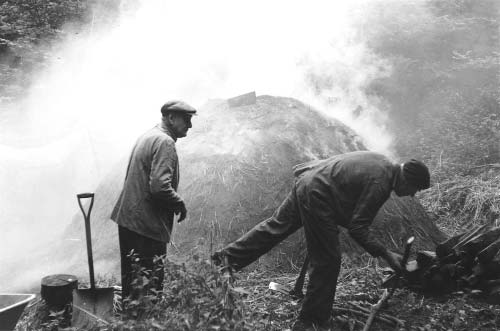Local History Society Report
Woodlands of the South Pennines - their industrial history
Speaker: Hywel Lewis
Wednesday, 6 March 2019
For modern day residents and visitors to the Calder Valley our woodlands are largely a place of leisure, serving as an escape from the industrial towns, but as Hywel Lewis told the Hebden Bridge Local History Society, their history shows how closely they were integrated in the industrial economic life of this area.
Hywel is nearing the end of a PhD study of the management and use of woodlands in the South Pennines - a study which combines mapping of various landscape features of the woodlands; detailed scientific analysis of archaeological finds; searching for documentary evidence and practical re-creation of ancient techniques.

The steep, unpromising woodlands of our valleys actually played an important part in the industrialisation of the region - the legacy of which can be seen to this day.
With teams of volunteers organised by Pennine Prospects, 150 hectares of woodland at Hardcastle Crags have been surveyed and features such as walls, tracks and charcoal burning circles recorded.
Medieval times
In medieval times these steep wooded hillsides would have been open common, not fenced or closely managed, but by late medieval times there is evidence that boundary walls were being constructed. Stock would have certainly been grazing in the woodlands, and the tracks and ways linking with farm settlements on the higher flatter ground provide some evidence of this. Maps show that the woodlands were parcelled up and often became known by the name of the adjoining farms; these divisions too can be seen in the remains of old boundary walls.
Charcoal burning
The link between the woodland and the local industries is most clearly shown in the almost ubiquitous presence of charcoal burning sites – level circular areas which often have a wall base. The smallish branches of the trees would be allowed to smoulder under a blanket of bracken, turf and earth to produce the valuable charcoal. 84 such sites were found in Hardcastle Crags, and scientific analysis of the cellular structure of the wood showed that the most common was oak, but with birch and hazel also used. The growth rings showed an annual 10 or 20 years of growth to reach a diameter of about 2”.
All this feeds into an understanding of how the woodlands were being managed. The earliest date found by radio carbon dating was 1386, confirming that the exploitation of wood for charcoal was of long standing. The production of charcoal did not tail off in this area as it did in other parts of the country as industry moved to use other fuels. Charcoal was important to the local textile industry during the late 1700s and through much of the nineteenth century as the production of worsted cloth relied on the woolcombers who in turn relied on charcoal burners to heat the special combs that provided the long straight wool threads essential for this superior fabric.
Iron smelting
Another industry that was part of the woodlands was iron smelting. The evidence of small scale ‘bloomery’ smelting sites, which used clay cylinders, remains in the mounds of iron slag which can be found, often close to paths. There is documentary evidence of itinerant workers who would carry out this process, and scoops out of the hillside in parts of the wood suggest that the iron ore was mined locally. Both bloomery smelting and charcoal burning were experienced in a recent Woodland Archaeology Festival held in Hardcastle Crags.
19th century management
In Hebden Bridge archives Hywel found documents which give a real and detailed insight into the management of woods during the later nineteenth century. George Sutcliffe of Stoneshey Gate left notebooks recording in detail the different kinds of trees, their management, felling and the value they made when they were sold. There were timber merchants who bid for the wood and sold it on to local industries, and oak bark, that made a third of the price of the timber, was sent to local tanneries.
Recreational value
Over time however, the long wait required for a coppice or trees to grow to the requisite size meant that the economic value of the woodland diminished. Nowadays their value is mainly recreational, and that is of course an important part of our local economy. Woodland has always been tied to the local economy, Hywel concluded, despite our imaginings of dark and dangerous wildwoods in ancient times.
At the next meeting of Hebden Bridge Local History Society Alan Fowler will talk about ‘Remembering Peterloo’. Everyone welcome at Hebden Bridge Methodist Church, starting at 7.30 on Wednesday 13 March.
With thanks to Sheila Graham for this report
Details of all the Society’s activities can be found on the website and you can also follow them on their Facebook page.
See also


